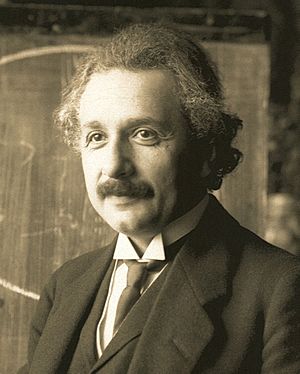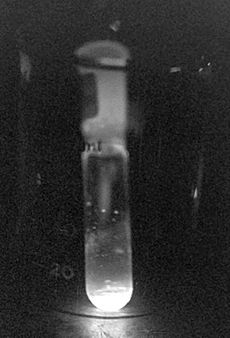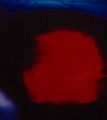Einsteinium facts for kids

Einsteinium is a special chemical element with the atomic number 99. This means that each atom of Einsteinium has 99 protons and 99 electrons. It is a man-made element, which means it doesn't exist naturally on Earth. All its different forms, called isotopes, are radioactive. This means they give off energy as they change over time.
Einsteinium is named after the famous scientist Albert Einstein. It was first found in 1952 by a team of scientists led by Albert Ghiorso. They discovered it in the leftover material from the first hydrogen bomb explosion. Later, it was officially identified as a new element at the University of California, Berkeley.
This element belongs to a group called the actinoids, and it's the seventh one in that group. The most stable type of Einsteinium has 99 protons, 99 electrons, and 153 neutrons. There are 19 different radioactive isotopes of Einsteinium. Each isotope has a half-life (the time it takes for half of it to decay) between 40 and 471 days. Einsteinium was even used to create another element called Mendelevium for the first time in 1955. Today, we don't know of any everyday uses for Einsteinium.
Contents
What is Einsteinium Like?
Physical Traits
Einsteinium is a man-made, shiny silver metal that is radioactive. On the periodic table, it sits next to californium and fermium. It is also below holmium, and shares many similar features with it.
Einsteinium is a soft metal. It has a low melting point of 860 °C. This is lower than many other similar elements. The strong radiation from Einsteinium causes it to damage itself very quickly. This damage releases a lot of energy, making the metal glow! This self-damage might be why it has a lower density and melting point.
Because Einsteinium is so radioactive and damages itself, scientists have to study it very carefully. They often measure it right after heating it up. This helps to fix some of the damage.
Chemical Traits
Like all actinoid elements, Einsteinium is quite reactive. Its most common form has a charge of +3, which gives it a pale pink color when dissolved in water. Scientists have also found a +2 charged form of Einsteinium. This +2 state is not seen in many other actinoid elements.
Einsteinium's Isotopes
There are 19 known isotopes of Einsteinium. These are different versions of the element with varying numbers of neutrons. All of them are radioactive. The most stable isotope is 252Es, which has a half-life of about 471 days. Other stable isotopes include 254Es (275 days) and 253Es (20 days). Most other isotopes have very short half-lives, often less than 30 minutes.
Nuclear Fission and Critical Mass
Einsteinium can undergo nuclear fission. This means its atoms can split apart, releasing a lot of energy. The isotope 254Es has a low critical mass. This is the smallest amount of material needed to start a continuous nuclear chain reaction. For 254Es, this mass is about 9.89 kilograms. This amount can be made even smaller by adding a special material called a neutron reflector. However, the total amount of Einsteinium ever made is much less than this critical mass.
Where is Einsteinium Found?
Because all Einsteinium isotopes have short half-lives, any Einsteinium that might have been on Earth when it formed has long since disappeared. It is also very unlikely for Einsteinium to form naturally in the Earth's crust. This is because it would require many neutron captures from other elements like uranium.
Therefore, all Einsteinium found on Earth is created in science labs, powerful nuclear reactors, or during nuclear weapons tests. It only exists for a few years after it's made.
Long ago, transuranic elements, including Einsteinium, were created in a natural nuclear reactor in a place called Oklo. However, this is no longer happening.
Scientists once thought they saw Einsteinium in the light from a star called Przybylski's Star. But the scientists who made this claim later admitted that they didn't have enough information to be sure. In 2021, the unique light patterns of Einsteinium were studied in labs. However, no new research has confirmed if the star's light matches these lab results.
| Periodic table | |||||||||||||||||||||||||||||||||||||||||
|---|---|---|---|---|---|---|---|---|---|---|---|---|---|---|---|---|---|---|---|---|---|---|---|---|---|---|---|---|---|---|---|---|---|---|---|---|---|---|---|---|---|
| H | He | ||||||||||||||||||||||||||||||||||||||||
| Li | Be | B | C | N | O | F | Ne | ||||||||||||||||||||||||||||||||||
| Na | Mg | Al | Si | P | S | Cl | Ar | ||||||||||||||||||||||||||||||||||
| K | Ca | Sc | Ti | V | Cr | Mn | Fe | Co | Ni | Cu | Zn | Ga | Ge | As | Se | Br | Kr | ||||||||||||||||||||||||
| Rb | Sr | Y | Zr | Nb | Mo | Tc | Ru | Rh | Pd | Ag | Cd | In | Sn | Sb | Te | I | Xe | ||||||||||||||||||||||||
| Cs | Ba | La | Ce | Pr | Nd | Pm | Sm | Eu | Gd | Tb | Dy | Ho | Er | Tm | Yb | Lu | Hf | Ta | W | Re | Os | Ir | Pt | Au | Hg | Tl | Pb | Bi | Po | At | Rn | ||||||||||
| Fr | Ra | Ac | Th | Pa | U | Np | Pu | Am | Cm | Bk | Cf | Es | Fm | Md | No | Lr | Rf | Db | Sg | Bh | Hs | Mt | Ds | Rg | Cn | Uut | Fl | Uup | Lv | Uus | Uuo | ||||||||||
|
|||||||||||||||||||||||||||||||||||||||||
Images for kids
-
The element was discovered by a team headed by Albert Ghiorso.
See also
 In Spanish: Einstenio para niños
In Spanish: Einstenio para niños








